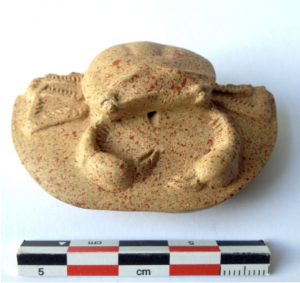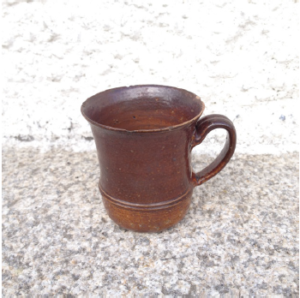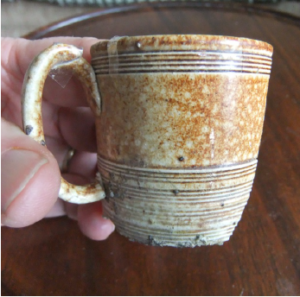‘Go on, go on, go on.’
Did you know that per capita Ireland is the world’s second greatest consumers of tea?
(Turkey has the first place spot.)
This love affair with tea started in the eighteenth century. If you were a guest at an upper class house like Rathfarnham Castle, you would have certainly been served tea. Perhaps the Loftuses would have even sent ‘for a harper to play’, as they did for Lord and Lady Shelburne on their visit to Rathfarnham in 1770. The 2014-15 excavations at Rathfarnham have provided us with physical evidence of the Castle’s tea drinking history. Eleven Chinese porcelain tea bowls (not cups, as you’ll notice that there wasn’t a handle), and the cover of a teapot, which was decorated with a crab were uncovered.

It cost how much?!
However, you might have been disappointed with your bowl of tea, as due to its high cost people tried to use as few tea leaves as possible. In the accounts of Newbridge House, Donabate from April 1724, a purchase of a pound of tea is listed as costing 16 shillings and 6 pence. It is difficult to convert that into today’s money, but it would have been well over €100. And keep in mind that a pound of tea is what you get in a box of 160 teabags! At that price you can understand why they often dried the leaves and reused them.
Milk, Two Sugars?
This weak eighteenth century tea was also sweet and fairly milky. The addition of sugar to tea was a continuation of how they added sugar to their wine. And adding milk was a way of diluting the believed harmful effects of the tea. Along with these typical ways of serving tea, there are humorous accounts of some of the strange ways that tea was served in its early days. One household in Britain just served the stewed tea leaves to their guests, leaving the liquid with the servants. Another reference from America did a similar thing, but they also mixed the leaves with butter prior to serving. Or perhaps you would like to try your tea as Queen Anne had it, cold with a little gin!
Wake up and try not to smell the coffee


Tea was only the latest hot beverage to be imported into Europe. Prior to tea, there had been hot chocolate and coffee to enjoy. Coffee in particular was very popular. Typically, it was served in coffee houses and not at home. However, the three coffee cans found at Rathfarnham suggests that the residents of the Castle liked to have their coffee at home. These English stoneware coffee cans date to the end of the seventeenth and beginning of the eighteenth century. This was the period when coffee houses were most at their most popular. As coffee houses were generally associated with people involved in law, politics, business and trade, coffee was consumed mainly by men. Unfortunately for these coffee drinkers, the taste was described as ‘syrup of soot’ and ‘essence of boiled shoes’. In appearance it was similar to a Turkish coffee, and while it was weaker than today’s coffee, the caffeine hit was obviously strong enough that people overlooked the fact that it ‘smelled like old crusts and leather’.
Random Facts about Tea and Coffee
Tea
After water tea is the most widely consumed beverage in the world.
The Portuguese were the first Europeans to encounter tea in China during the late sixteenth century. As with many fashions royalty had a huge influence on the adoption of tea drinking. Charles II’s Portuguese wife, Catherine Braganza, was a big fan of tea and made it so popular in England that alcohol consumption decreased in the late seventeenth century.
Tea created the USA’s first three millionaires in 1800. With faster ships they were able to break Britain’s worldwide monopoly on tea.
In the years after the Famine people in Ireland increased their consumption of tea four-fold.
The tea trade was serious business and even led to wars. By the end of the eighteenth century Britain had a huge trade deficit with China. Much of this was due to all the Chinese tea that Britain bought. Opium, which Britain’s East India Company had a monopoly on, was used to balance this deficit. When China banned opium and enforced their anti-smuggling laws, it led to the Opium Wars (1839-1842, 1856-1860).
Earl Grey tea is reputedly named after Earl Charles Grey, although why is a matter of disagreement. Earl Grey was Prime Minister from 1830-34 and is remembered for passing the Reform Act and Slavery Abolition Act. He also ended the East India Company’s trade monopolies, including their monopoly on tea in Britain.
By 1904 Ireland had surpassed Britain in tea consumption. Also in this year, tea (and the sugar that went with it) accounted for 20% of food expenses in Irish households.
Coffee
Coffee houses made newspapers and pamphlets available to their customers, making them good places to get information or hear new ideas. Consequently, they were sometimes referred to as ‘penny universities’ in England.
Some of these discussions worried authorities that it could lead to revolution. Charles II was so worried that coffee houses were places of sedition and treason that he attempted to ban them in 1675. However, such was the uproar that this decision was revoked 11 days later, before the ban was actually enacted. Do not get in between someone and their coffee!
There were also apparently opposition to coffee from women. The Women’s Petition Against Coffee (1674) described coffee as ‘a little base, black, thick, nasty, bitter, stinking nauseous puddle water’. The reason for the opposition was apparently because it kept men away from home and made them impotent.
Each coffee house had its own clientele and reputation. Daly’s Club on Dame Street was one of Dublin’s most famous. Serving both members of parliament and young ‘bucks’ with money, Daly’s was renowned for its gambling. It was said that Daly’s was ‘where half the land of Ireland has changed hands’. Other coffee houses had a more violent reputation. The courtyard of Lucas’ on Cork Hill was the site of 8 duels from 1748-1758.
Europe has only one coffee plantation. It is in Gran Canaria’s Valle de Agaete.
While Ethiopia is the home of the Arabica coffee and Java is associated with Robusta beans, the largest producer of coffee for the last 150 years is Brazil.
What do you prefer to drink: Tea or Coffee?
